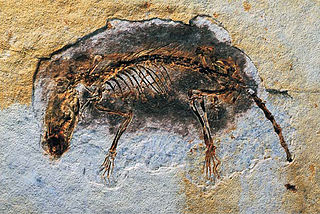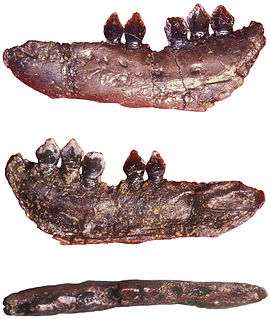Related Research Articles
The Cretaceous is a geological period that lasted from about 145 to 66 million years ago (mya). It is the third and final period of the Mesozoic Era, as well as the longest. At nearly 80 million years, it is the longest geological period of the entire Phanerozoic. The name is derived from the Latin creta, 'chalk', which is abundant in the latter half of the period. It is usually abbreviated K, for its German translation Kreide.

Eomaia is a genus of extinct fossil mammals containing the single species Eomaia scansoria, discovered in rocks that were found in the Yixian Formation, Liaoning Province, China, and dated to the Barremian Age of the Lower Cretaceous about 125 million years ago. The single fossil specimen of this species is 10 centimetres (3.9 in) in length and virtually complete. An estimate of the body weight is between 20–25 grams (0.71–0.88 oz). It is exceptionally well-preserved for a 125-million-year-old specimen. Although the fossil's skull is squashed flat, its teeth, tiny foot bones, cartilages and even its fur are visible.

Metatheria is a mammalian clade that includes all mammals more closely related to marsupials than to placentals. First proposed by Thomas Henry Huxley in 1880, it is a slightly more inclusive group than the marsupials; it contains all marsupials as well as many extinct non-marsupial relatives.
The Late Cretaceous is the younger of two epochs into which the Cretaceous geological period is divided in the geologic time scale. Rock strata from this epoch form the Upper Cretaceous series. The Cretaceous is named after the white limestone known as chalk which occurs widely in northern France and is seen in the white cliffs of south-eastern England, and which dates from this time.
Condylarthra is an informal group – previously considered an order – of extinct placental mammals, known primarily from the Paleocene and Eocene epochs. They are considered early, primitive ungulates. It is now largely considered to be a wastebasket taxon, having served as a dumping ground for classifying ungulates which had not been clearly established as part of either Perissodactyla or Cetartiodactyla, being composed thus of several unrelated lineages.

Echinodon is a genus of heterodontosaurid dinosaur that lived during the earliest Cretaceous of southern England in the Berriasian epoch. The first specimens were jaw bones named Echinodon becklesii by Sir Richard Owen in 1861, and since their original description only additional teeth have been discovered. The specific name honours collector Samuel Beckles who discovered the material of Echinodon and many other taxa from across England, while the genus name translates as "prickly tooth" in reference to the dental anatomy of the taxon.

Protungulatum is an extinct genus of mammal first found in the Bug Creek Anthills in northeastern Montana. The Bug Creek Anthills were initially believed to be Late Cretaceous because of the presence of the remains of non-avian dinosaurs and common Cretaceous mammals, but these were later shown to have been reworked from Late Cretaceous strata, and consequently the Bug Creek Anthills are currently believed to be Early Paleocene (Puercan) in age. Remains from the Ravenscrag Formation of Saskatchewan, Canada have been assigned to P. donnae. These remains may also be Cretaceous in age, but the age of the Ravenscrag Formation is not entirely certain. In 2011, remains of a new species of Protungulatum, P. coombsi, from the Hell Creek Formation, which is definitely Late Cretaceous (Maastrichtian) in age, proved that Protungulatum was present in both the Cretaceous and the Paleocene. It was initially assigned to the order condylarthra, a group of archaic "ungulates", that is now known to be polyphyletic. According to Archibald et al. (2011), Protungulatum is not even definitely a placental mammal. Some studies have found it to be close to Cetartiodactyla, but the most recent analysis holds it to be a non-placental eutherian.
Cimolestes is a genus of early eutherians with a full complement of teeth adapted for eating insects and other small animals. Paleontologists have disagreed on its relationship to other mammals, in part because quite different animals were assigned to the genus, making Cimolestes a grade taxon of animals with similar features rather than a genus of closely related ones. Fossils have been found in North America, where they first appeared during the Late Cretaceous. According to some paleontologists, they died out at the start of the Paleocene, while others report the genus from the early Eocene.

Vincelestes is an extinct genus of actively mobile mammal, that lived in what would be South America during the Early Cretaceous from 130—112 mya, existing for approximately 18 million years .

Dryolestida is an extinct order of mammals; most of the members are mostly known from the Jurassic to Paleogene, with one member, Necrolestes, surviving as late as the early Miocene. They are considered members of the clade Cladotheria, close to the ancestry of therian mammals. It is also believed that they developed a fully mammalian jaw and also had the three middle ear bones. Other than that, not much is known about them, this is because their fossils are made up mostly of jaw and tooth remains.

Leptictida is a possibly invalid extinct order of placental mammals. Their classification is contentious: according to cladistic studies, they may be (distantly) related to Euarchontoglires, although they are more recently regarded as the first branch to split from basal eutherians. One recent large-scale cladistic analysis of eutherian mammals favored lepictidans as close to the placental crown-clade; and several other recent analyses that included data from Cretaceous non-eutherian mammals found Leptictis to belong to the superorder Afrotheria.
Borisodon is an extinct genus of eutherians which existed in what is now Kazakhstan during the Turonian age. It was described by J. David Archibald and Alexander Averianov in 2012, as a new genus for the species Sorlestes kara, which was originally described by Nessov in 1993. The type specimen was a mandible, discovered at Near Ashchikol' Lake, drill core. Borisodon was a tree-climbing insectivore.

Acheroraptor is an extinct genus of dromaeosaurid theropod dinosaur known from the latest Maastrichtian Hell Creek Formation of Montana, United States. It contains a single species, Acheroraptor temertyorum. A. temertyorum is one of the two geologically youngest known species of dromaeosaurids, the other being Dakotaraptor, which is also known from Hell Creek. A basal cousin of Velociraptor, Acheroraptor is known from upper and lower jaw material.
Pappotherium is an extinct genus of mammals from the Albian of Texas, US, known from a fossilized maxilla fragment bearing two tribosphenic molars, discovered within the Glen Rose Formation near Decatur, Wise County, Texas.
Oxlestes is an extinct mammal from the Late Cretaceous of Asia, more specifically from the Cenomanian of Uzbekistan. A carnivorous species of uncertain affinities, it is notable for its relatively large size, being among the largest of all Mesozoic mammals. Due to the limited amount of material, it has been considered a nomen dubium.
Schowalteria is a genus of extinct mammal from the Cretaceous of Canada. It is the earliest known representative of Taeniodonta, a specialised lineage of non-placental eutherian mammals otherwise found in Paleocene and Eocene deposits. It is notable for its large size, being among the largest of Mesozoic mammals, as well as its speciation towards herbivory, which in some respects exceeds that of its later relatives.
Khukduklestes is a genus of extinct mammal of uncertain affinities from the Late Cretaceous of China. It is rather similar to the also carnivorous and taxonomically uncertain Oxlestes, being slightly smaller.
Zhelestidae is a lineage of extinct eutherian mammals. Occurring in the Late Cretaceous from the Turonian to the Maastrichtian, they were an extremely successful group, with representatives present in Europe, Asia, India, Africa and North America, ostensibly rendering them a cosmopolitan clade. They were specialised towards an herbivorous lifestyle and were in fact initially considered stem-ungulates, but the presence of epipubics and "archaic" dental characters render them as non-placental eutherians.

Zalambdalestidae is a clade of Asian eutherians occurring during the Late Cretaceous. Once classified as Glires, features like epipubic bones and various cranial elements have identified these animals as outside of Placentalia, representing thus a specialised clade of non-placental eutherians without any living descendants, and potentially rather different from modern placentals in at least reproductive anatomy.

Durlstodon is a genus of extinct mammal from the Early Cretaceous of Southern England. It contains a single species, Durlstodon ensomi, which is known from molars found in the Berriasian Lulworth Formation of Durlston Bay, Dorset, after which the genus was named. The species name honours Paul Ensom, discoverer of many fossil mammals from Lulworth. Durlstodon and two of its contemporaries, Tribactonodon and Durlstotherium, had tribosphenidan (three-cusped) molars, which are an advanced characteristic among eutherian mammals and suggest that the group emerged earlier than the Early Cretaceous.
References
- 1 2 3 4 Tabuce, R., Vianey-Liaud, M. and Garcia, G., 2004. A eutherian mammal in the latest Cretaceous of Vitrolles, southern France. Acta Palaeontologica Polonica, 49(3).
- ↑ Gheerbrant, E. and Astibia, H., 2012. Addition to the Late Cretaceous Laño mammal faunule (Spain) and to the knowledge of European “Zhelestidae”(Lainodontinae nov.). Bulletin de la Société géologique de France, 183(6), pp.537-546.
- ↑ Archibald, J.D. and Averianov, A., 2012. Phylogenetic analysis, taxonomic revision, and dental ontogeny of the Cretaceous Zhelestidae (Mammalia: Eutheria). Zoological Journal of the Linnean Society, 164(2), pp.361-426.
| | This prehistoric mammal-related article is a stub. You can help Wikipedia by expanding it. |




